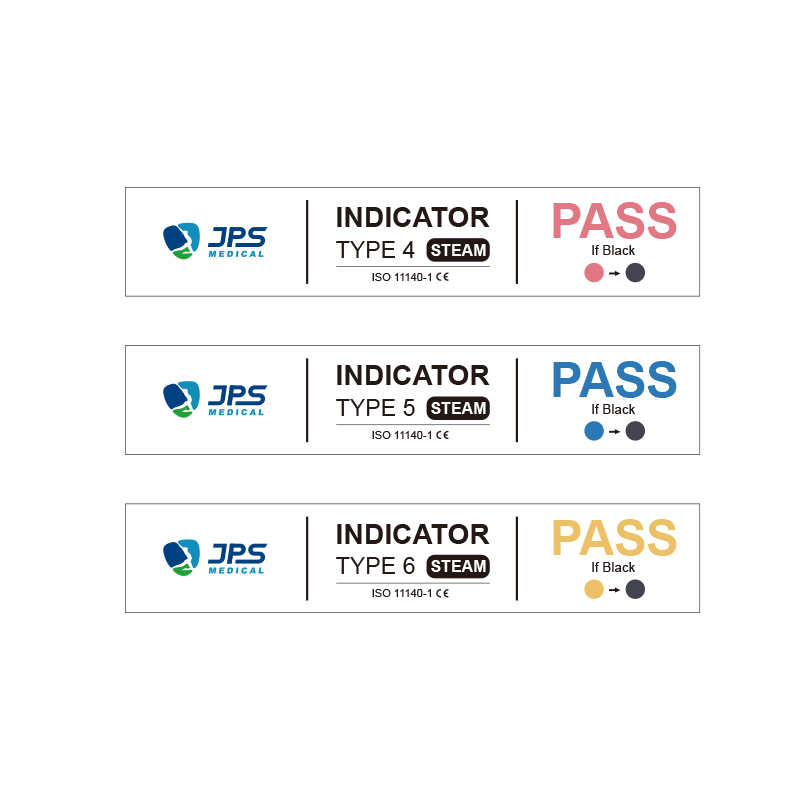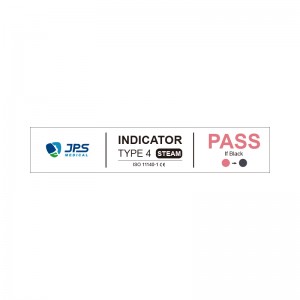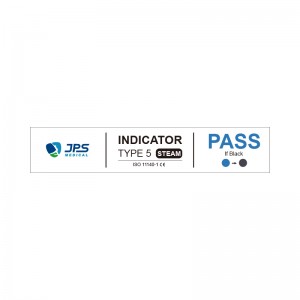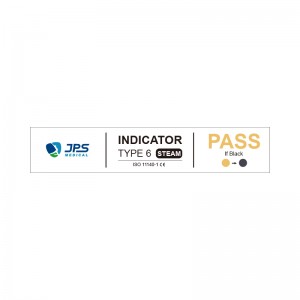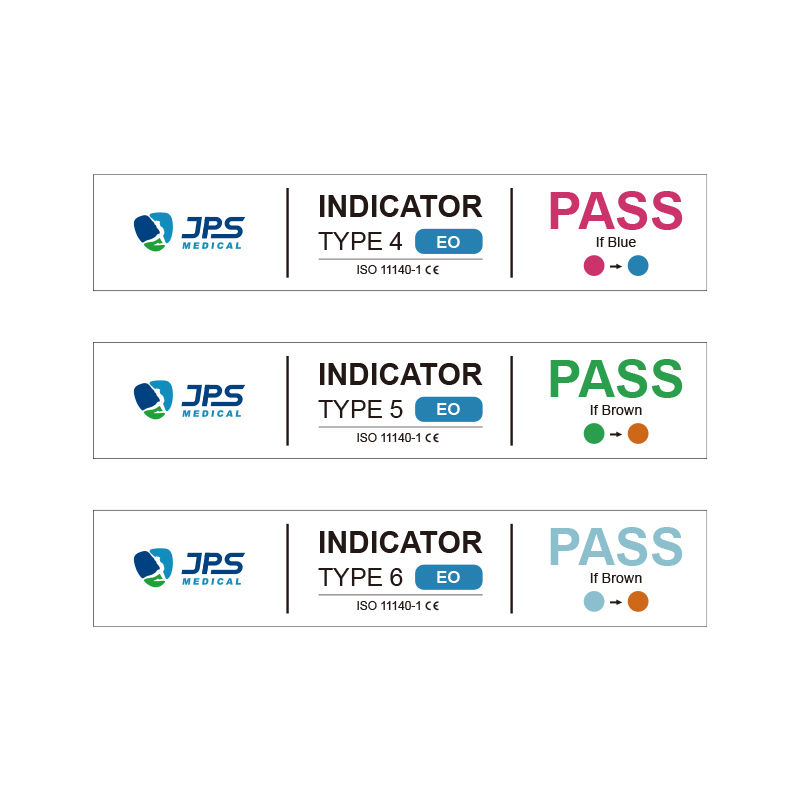Pressure Steam Sterilization Chemical Indicator card
The specification we offer is as follow:
| Items | Color change | Packing |
| Steam indicator strip | Initial color to black | 250pcs/box,10boxes/carton |
1. Preparation:
Ensure all items to be sterilized are properly cleaned and dried.
Place items in appropriate sterilization packaging (e.g., pouches or wraps).
2. Placement of the Indicator Card:
Insert the Chemical Indicator Card inside the sterilization package with the items.
Ensure the card is positioned in a way that it will be fully exposed to the steam during the sterilization cycle.
3. Sterilization Process:
Load the sterilization packages into the pressure steam sterilizer (autoclave).
Set the sterilizer’s parameters (time, temperature, pressure) according to the manufacturer’s instructions for the items being sterilized.
Start the sterilization cycle.
4. Post-Sterilization Check:
After the sterilization cycle is complete, carefully remove the packages from the sterilizer.
Allow the packages to cool before handling.
5. Verify the Indicator Card:
Open the sterilization package and inspect the Chemical Indicator Card.
Check for a color change on the card, which confirms exposure to the appropriate sterilization conditions. The specific color change will be indicated on the card or packaging instructions.
6. Documentation and Storage:
Record the results of the indicator card in your sterilization log, noting the date, batch number, and any other relevant details.
Store the sterilized items in a clean, dry environment until they are ready for use.
7. Troubleshooting:
If the Chemical Indicator Card does not show the expected color change, do not use the items. Reprocess them according to your facility’s guidelines and investigate potential issues with the sterilizer.
These core advantages make the Pressure Steam Sterilization Chemical Indicator Card an essential tool for ensuring the safety and reliability of sterilization processes in various professional settings.
Hospitals:
· Central Sterilization Departments: Ensures surgical instruments and medical devices are properly sterilized.
· Operating Rooms: Verifies the sterility of tools and equipment before procedures.
Clinics:
· General and Specialty Clinics: Used to confirm sterilization of instruments used in various medical treatments.
Dental Offices:
· Dental Practices: Ensures dental tools and equipment are effectively sterilized to prevent infections.
Veterinary Clinics:
· Veterinary Hospitals and Clinics: Confirms the sterility of instruments used in animal care and surgery.
Laboratories:
· Research Laboratories: Verifies that laboratory equipment and materials are free from contaminants.
· Pharmaceutical Labs: Ensures that tools and containers used in drug production are sterile.
Biotech and Life Sciences:
· Biotech Research Facilities: Confirms the sterility of equipment and materials used in research and development.
Tattoo and Piercing Studios:
· Tattoo Parlors: Ensures needles and equipment are sterilized to prevent infections.
· Piercing Studios: Verifies the sterility of piercing tools.
Emergency Services:
· Paramedics and First Responders: Confirms that emergency medical equipment is sterile and ready for use.
Food and Beverage Industry:
· Food Processing Plants: Verifies that processing equipment and containers are sterilized to maintain hygiene standards.
Educational Institutions:
· Medical and Dental Schools: Used in training programs to teach proper sterilization techniques.
· Science Laboratories: Ensures that educational lab equipment is sterilized for student use.
These diverse application areas highlight the versatility and importance of the Pressure Steam Sterilization Chemical Indicator Card in ensuring effective sterilization across various professional settings.
These strips offer the highest level of sterility assurance from a chemical indicator and are used to verify that ALL critical steam sterilization parameters have been met. In addition, Type 5 indicators meet the stringent performance requirements of the ANSI/AAMI/ISO chemical indicator standard 11140-1:2014.
Indicator strips used for sterilization are chemical indicators designed to monitor and verify that sterilization processes have been effectively carried out. These strips are used in various sterilization methods such as steam, ethylene oxide (ETO), dry heat, and hydrogen peroxide (plasma) sterilization. Here are the key purposes and uses of these indicator strips:
Sterilization Verification:
Indicator strips provide a visual confirmation that items have been exposed to the correct sterilization conditions (e.g., appropriate temperature, time, and presence of sterilizing agent).
Process Monitoring:
They are used to monitor the effectiveness of the sterilization process, ensuring that the conditions within the sterilizer are adequate to achieve sterilization.
Quality Control:
These strips help in maintaining quality control by ensuring that each sterilization cycle meets the required standards. This is critical for maintaining the safety and sterility of medical instruments and devices.
Regulatory Compliance:
Use of indicator strips helps healthcare facilities comply with regulatory and accreditation standards for sterilization practices, ensuring that they follow the best practices for infection control.
In-Package Placement:
Indicator strips are placed inside sterilization packages, pouches, or trays, directly with the items to be sterilized. This ensures that the sterilizing agent reaches the items effectively.
Visual Indicator:
The strips change color or display specific markings when exposed to the correct sterilization conditions. This color change is easily interpretable and provides immediate feedback on the success of the sterilization process.
Preventing Cross-Contamination:
By confirming the sterility of instruments and materials, indicator strips help prevent cross-contamination and infections, ensuring patient and user safety.
Sterilization indicator strips are essential tools for verifying and monitoring the efficacy of various sterilization processes, providing crucial quality control, regulatory compliance, and ensuring the safety of medical and laboratory environments.
Sterilization indicator strips are used to confirm that sterilization processes, such as autoclaving, have been effective in achieving the necessary conditions to render items free of viable microorganisms. These strips incorporate specific chemical or biological indicators that respond to the physical or chemical conditions within the sterilization environment. Here are the key principles behind how they work:
Color Change: The most common type of sterilization indicator strip uses a chemical dye that changes color when exposed to specific conditions, such as temperature, pressure, and time.
· Thermochemical Reaction: These indicators contain chemicals that undergo a visible color change when they reach the threshold sterilization conditions, typically 121°C (250°F) for 15 minutes under steam pressure in an autoclave.
· Process Indicators: Some strips, known as process indicators, change color to signify that they have been exposed to the sterilization process but do not confirm that the process was sufficient to achieve sterility.
Classifications: According to ISO 11140-1 standards, chemical indicators are classified into six types based on their specificity and intended use:
· Class 4: Multi-variable indicators.
· Class 5: Integrating indicators, which react to all critical parameters.
· Class 6: Emulating indicators, which provide results based on exact cycle parameters.

